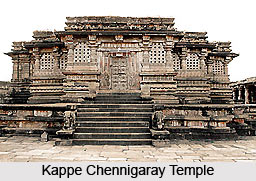 Kappa Chenningaray Temple was built by queen Shantaladevi. It has beautiful sculptures of Lord Ganesh, Goddess Saraswati, Shridhar and Durga Mahishasuramardini. Towards the west is stands Lord Vishnu as Kappe-Chennigaray.
Kappa Chenningaray Temple was built by queen Shantaladevi. It has beautiful sculptures of Lord Ganesh, Goddess Saraswati, Shridhar and Durga Mahishasuramardini. Towards the west is stands Lord Vishnu as Kappe-Chennigaray.
There are other shrines that are situated around the temple dedicated to Veeranarayana (Vishnu), Sridevi and Bhoodevi, Soumyanayaki and Ranganayaki. This temple is located in the south side of Chennakeshava temple. The main part has a sculpture of Chennakeshava. The Prabhavali has sculptures of Dasavatara. The Pitha has an inscription of Queen Shantala of Hoysala King Vishnuvardana. The temple is built over an elevated platform. The pierced side walls were done at the time of Ballala II in 1206.
The Sukhanasi doorway is illustrated with a figure of Lakshminarayana that has been flanked by makaras on the lintel. The doorway has the Venugopal Shrine where Narasimha killing Hiranyaksha has been portrayed. The four pillars of the Navaranga have bracket figures on them.
This article is a stub. You can enrich by adding more information to it. Send your Write Up to content@indianetzone.com





















